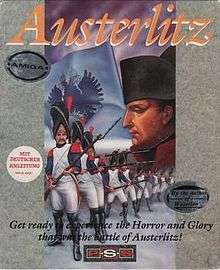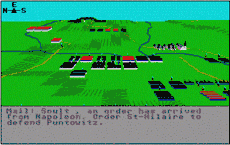Austerlitz (video game)
Austerlitz is a turn-based strategy video game developed by Personal Software Services and published by Mirrorsoft. It was released in the United Kingdom and Germany for the Amiga, Atari ST and MS-DOS home computers in 1989. It was also re-released in France for Amiga home computers by Mirror Image in 1991. The game is set during the Battle of Austerlitz of the Napoleonic Wars and revolves around Napoleon's forces defending the Austrian village of Austerlitz from the invading army of Alexander I of Russia.
| Austerlitz | |
|---|---|
 Amiga cover art | |
| Developer(s) | Personal Software Services |
| Publisher(s) | Mirrorsoft |
| Designer(s) | Peter Turcan |
| Series | Strategic Wargames |
| Platform(s) | Amiga, Atari ST, MS-DOS |
| Release |
|
| Genre(s) | Turn-based strategy |
| Mode(s) | Single-player |
The game was developed by Peter Turcan, who also developed similar turn-based strategies such as Waterloo and Borodino for home computers in the 1980s. Austerlitz is presented in a 3D perspective over a battlefield; however, it features no sound. The game received mostly positive reviews upon release. Critics praised the graphics and presentation; however, some were divided over the historical accuracy of the battle and lack of sound.
Gameplay

The game is a turn-based strategy and revolves around Battle of Austerlitz, in which the forces under the command of Napoleon must defend the Austrian village of Austerlitz from the invading Austro-Russian army, led by Tsar Alexander. In the game, the battle itself begins at 7 am on 2 December 1805 and is played out in a series of turns.[1] A turn lasts fifteen minutes and a total number of eight orders must be issued before the end of the turn.[2] The player may choose either French or Russian forces to control throughout the game. In order to move a unit, the player must select them and point their cursor over the desired location; however, movement is restricted within a turn.[1] At the start of a movement phase, the player can issue a command to one of their units. Orders include move, attack, defend, shell, stay in reserve, retreat and report.[1]
Rotating the map using a compass is essential for ensuring an army moves in the desired direction.[1] The order of a moving unit will not be carried out until the unit has reached its destination or if they have been killed before arriving there. Each order carried out is announced through the game's command box, which is situated at the bottom of the screen. Actions such as battles and unit losses are also announced.[1] In order to attack the enemy from a distance, the player is able to order a unit to commence shelling, which will neutralise an enemy unit if successful.[2] The game features no sound.[2][1]
Background
Personal Software Services was founded in Coventry, England, by Gary Mays and Richard Cockayne in November 1981.[3] The company was known for creating games that revolved around historic war battles and conflicts, such as Theatre Europe, Bismarck and Falklands '82. The company had a partnership with French video game developer ERE Informatique, and published localised versions of their products to the United Kingdom.[4] The Strategic Wargames series was conceptualised by software designer Alan Steel in 1984. During development of these titles, Steel would often research the topic of the upcoming game and pass on the findings to other associates in Coventry and London.[5] Some games of the series were met with controversy upon release, such as Theatre Europe.[3][5] In 1983, the company received recognition for being "one of the top software houses" in the United Kingdom, and was a finalist for BBC Radio 4's New Business Enterprise Award for that year.[6] Austerlitz was developed by Peter Turcan, who also developed similar turn-based strategies, such as Waterloo and Borodino for the Atari ST.[2][1] The game was previewed in an issue of Crash in July 1989.[7]
In 1986, Cockayne took a decision to alter their products for release on 16-bit consoles, as he found that smaller 8-bit consoles, such as the ZX Spectrum, lacked the processing power for larger strategy games. The decision was falsely interpreted as "pulling out" from the Spectrum market by video game journalist Phillipa Irving.[8] Following years of successful sales throughout the mid 1980s, Personal Software Services experienced financial difficulties, in what Cockayne admitted in a retrospective interview that "he took his eye off the ball". The company was acquired by Mirrorsoft in February 1987,[9] and was later dispossessed by the company due to strains of debt.[10]
Reception
| Reception | ||||||||||||||||
|---|---|---|---|---|---|---|---|---|---|---|---|---|---|---|---|---|
| ||||||||||||||||
The game received mostly positive reviews upon release. John Highcliffe of The Games Machine praised the historical accuracy of the game, stating that gamers with an interest with the era would enjoy the game. However, Highcliffe expressed concern over the slow pace of the game.[11] Alain Huyghes-Lacour of Tilt praised the game's graphics and 3D presentation of the battle, stating that it exceeded the benchmark set by other wargames.[12] Mark Higham of ST Format questioned the historical accuracy, stating that during the real battle French forces used smoke grenades frequently, and criticised the lack of this inclusion in the game. However, Higham heralded the game as the best, saying that there is "no other wargame like it".[1]
Mark Patterson of ACE praised the smooth animation and impressive graphics; however, he criticised the game's lack of sound as uninspiring.[2] Higham considered Austerlitz superior to other games released by the developer, suggesting that it offered a higher state of realism.[1] Lucinda Orr of Amiga Computing stated that the graphics were "wonderful" and opinionated that the game was the best Napoleon warfare simulation of its kind.[15] A reviewer of Amiga Format said that the 3D graphics were "great", but declared that the lack of sound was the "last thing" a player would need in a serious wargame.[16] Jonathan Davies of Amiga Power praised the graphics as the only "plus side" aspect of the game, however he criticised the slow pace of gameplay, stating that it would take hours and a lot of patience to type out orders.[13] A reviewer of Australian Commodore and Amiga review asserted that Austerlitz was designed for serious gamers, stating that the complexity of the game would make "seasoned wargamers happy as pigs in mud".[17]
References
- Higham, Mark (April 1989). "Austerlitz review". ST Format (8): 48, 49. Retrieved 16 January 2016.
- Patterson, Mark (March 1990). "Austerlitz review". ACE (30): 40. Retrieved 16 January 2016.
- "History of PSS". Your Computer. 6 (6): 84–85. 13 June 1986. Retrieved 3 October 2015.
- "Personal Software Services overview". Retro Aisle. Retrieved 18 October 2015.
- Connor, Peter (March 1986). "Special: PSS". Amstrad Action (6): 97–99. Retrieved 5 February 2016.
- "PSS: Blade Alley Competition". Crash (5): 28. June 1984. Retrieved 5 February 2016.
- "Preview section". Crash (66): 49. July 1989. Retrieved 3 February 2016.
- Jarratt, Steve (May 1988). "Seasonal Drought". Crash (52): 7. Retrieved 18 October 2015.
- "Mirrorsoft has new strategy with PSS". Personal Computing Weekly. 6 (7): 6. 12 February 1987. Retrieved 18 October 2015.
- Arnot, Chris (26 March 1995). "Taking pain out of gain". The Independent. Retrieved 4 October 2015.
- Highcliffe, John (March 1990). "Austerlitz review". The Games Machine (28): 87. Retrieved 16 January 2016.
- Huyghes-Lacour, Alain (March 1990). "Austerlitz review (Tilt)". Tilt (in French) (76): 80. Retrieved 16 January 2016.
- Davies, Jonathan (January 1991). "Austerlitz (Amiga Power)". Amiga Power (9). Retrieved 3 February 2016.
- "Austerlitz review". Power Play (in German) (24): 87. March 1990. Retrieved 3 February 2016.
- Orr, Lucinda (April 1990). "Austerlitz: War without tears". Amiga Computing. 2 (11): 40, 41.
- "Austerlitz review". Amiga Format (8): 53. March 1990. Retrieved 3 February 2016.
- "Mind Games: Austerlitz". Australia Commodore and Amiga review. 8 (2): 75. February 1991. Retrieved 3 February 2016.